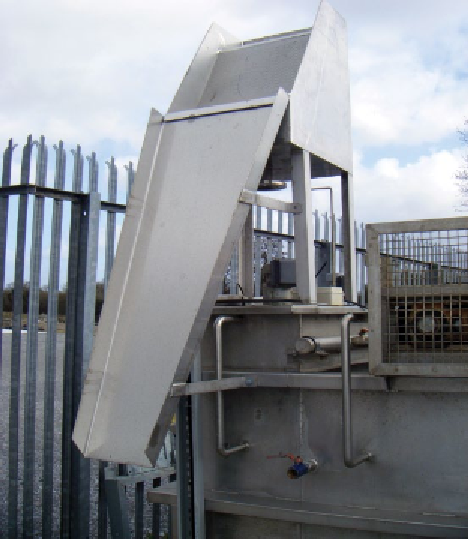Agriculture Reference
In-Depth Information
polyelectrolytes and others. Each flocculant works at an
optimal pH range. The pH of the effluent has to be
adjusted and varies depending on the flocculant used.
Typically, the addition of caustic soda or hydrochloric
acid is used to control the effluent pH (Fig. 3.10).
Balancing tanks
may be required when strict control
of hourly and daily flow rates is required or when
production is cyclical throughout a 24-hour period.
Balancing tanks should be aerated to maintain a fresh
wastewater and avoid odour generation.
Secondary treatment
Secondary treatment is carried out using various types
of
biological treatment systems
, which involve maintain-
ing under controlled conditions a mixed culture of
micro-organisms which utilise the continuous supply
of organic matter present in the effluent to synthesise
new cells.
Anaerobic digestion
is carried out in totally enclosed
systems to prevent the entry of air. It will result in a
fast reduction of organic material with the production
of biogas. With a BOD higher than 2000 mg/l, it
becomes advantageous. The system operates as a two-
stage fermentation process in which the stages occur
simultaneously within the digester.
During the first stage, bacteria break down complex
organic substances into simpler compounds, the most
important being volatile fatty acids (VFA). In the sec-
ond stage, methanogenic organisms utilise the VFA to
yield methane and carbon dioxide. Maintaining the
pH at around 7.0-7.2 is very important. Overproduction
of VFA will lower the pH and stop the process, which
can be difficult to re-start. This is very much a 'living'
process, and the addition of a balanced effluent is
essential. Too much protein can destroy the process,
and therefore, blood must not be introduced. There is
a high capital cost, the operatives require extensive
training, and the surplus treated effluent requires fur-
ther aerobic treatment before it can be discharged into
water courses.
Figure 3.9
Wedge wire rundown screen (by courtesy of Enisca,
Cookstown, Northern Ireland).
need the organic content to be reduced by washing. After
the removal of coarse solids, the effluent stream still
contains finely SS, fats and grease. Further screening
may be required. Coarse screening generally will be
10-25 mm with fine screening reducing to 5-6 mm. For
small quantities of low-grade material, a simple fat trap
is all that is required. This is in the form of a minimum-
turbulence, flow-through tank generally consisting of a
number of stages. Settleable solids can remain long
enough to settle out on the bottom of the tank, while
grease and fine solids rise to the surface. Continuous
sludge removal and skimming of the surface to remove
scum are essential (Fig. 3.9).
Dissolved air flotation
(DAF) is a successful method of
removing SS, fats, grease, and BOD and is particularly
useful to provide partial treatment for discharge to a
sewer. It causes a physical separation of suspended mat-
ter, fats and grease by the production of micro-bubbles
of air that attach themselves to the suspended material,
lifting it to the surface to form scum, which is removed
by a continuous scraper mechanism, while the superna-
tant liquor is discharged continuously either to a sewer
or for further biological treatment. The addition of
chemicals that aid flocculation results in a higher
removal efficiency of BOD, SS and fat. A large range of
flocculants is available, for example, ferric chloride/sul-
phate, ferrous sulphate, aluminium sulphate (alum),
sodium carbonate (soda ash), calcium carbonate (lime),
Activated sludge process
Aerobic digestion
is less sensitive to shock loading; the
retention time is shorter, and therefore, the tanks are
smaller and cheaper. Air is added via low-pressure air
blowers in combination with fine bubble air diffusers or
by using surface aerators powered by geared motors
(Fig. 3.11).
The factors which affect the degree of aeration required
by the reactor are concentration of dissolved oxygen,
the hydraulic retention time and substrate-loading rate,
pH, temperature, presence of toxic substances, nutrient
content and discharge consent requirement.

